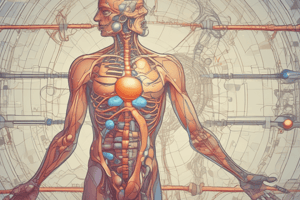Podcast
Questions and Answers
What is homeostasis?
What is homeostasis?
- The condition of having constant external influences on internal systems.
- A fixed state of all physiological parameters in the body.
- A state of instability in the body's internal conditions.
- The body's ability to maintain a dynamic stability of internal conditions. (correct)
What is a setpoint?
What is a setpoint?
- A physiological value around which the normal range fluctuates. (correct)
- The highest acceptable level of physiological conditions.
- A direct measurement of the body's current state.
- A constant value that cannot change regardless of external conditions.
At what body temperature is a person considered to have a fever?
At what body temperature is a person considered to have a fever?
- Above 38°C (100.4°F) (correct)
- Above 37°C (98.6°F)
- Below 35°C (95°F)
- Between 36°C (96.8°F) and 37°C (98.6°F)
Which physiological condition is NOT considered in maintaining homeostasis?
Which physiological condition is NOT considered in maintaining homeostasis?
What happens when body temperature rises above the normal range during exercise?
What happens when body temperature rises above the normal range during exercise?
Which of the following factors can affect an individual's temperature setpoint?
Which of the following factors can affect an individual's temperature setpoint?
What physiological response occurs when the body heats up due to external conditions?
What physiological response occurs when the body heats up due to external conditions?
Which condition is characterized by a body temperature that falls below 35°C (95°F)?
Which condition is characterized by a body temperature that falls below 35°C (95°F)?
Which physiological variable is not homeostatically regulated?
Which physiological variable is not homeostatically regulated?
What is the primary function of negative feedback in homeostasis?
What is the primary function of negative feedback in homeostasis?
What distinguishes positive feedback from negative feedback?
What distinguishes positive feedback from negative feedback?
Which of the following is an example of a positive feedback loop in the human body?
Which of the following is an example of a positive feedback loop in the human body?
In the context of heart rate, what is considered the 'effector'?
In the context of heart rate, what is considered the 'effector'?
Which statement best describes negative feedback?
Which statement best describes negative feedback?
Why can heart rate vary widely, from 50 to 195 beats per minute?
Why can heart rate vary widely, from 50 to 195 beats per minute?
What happens when there is a deviation from the normal range in a homeostatic system?
What happens when there is a deviation from the normal range in a homeostatic system?
Flashcards are hidden until you start studying
Study Notes
Homeostasis and Internal Conditions
- Homeostasis refers to the dynamic stability of the body's internal conditions necessary for cell health.
- Key internal parameters: oxygen levels, pH, nutrient availability, and temperature must remain stable for cellular function and survival.
Setpoints and Variability
- A setpoint is the physiological value around which normal conditions fluctuate, e.g., normal human body temperature is approximately 37°C (98.6°F).
- Setpoints vary among individuals influenced by metabolic rate, body mass, age, and biological sex.
- Acceptable temperature range: 35°C to 38°C; hypothermia occurs below 35°C and fever above 38°C.
Mechanism of Maintaining Homeostasis
- The body continuously monitors internal conditions with temperature sensors, particularly during physical activity.
- During exercise, body temperature may rise, prompting skin sensors to inform a control center (often in the brain).
- The control center communicates with effectors (e.g., sweat glands) to initiate cooling through sweat production.
Regulation of Physiological Variables
- Not all variables are homeostatically regulated; heart rate is an exception, varying widely based on activity level—can be 50 beats per minute at rest and up to 195 beats per minute during exertion.
- The heart acts as an effector to maintain homeostatic levels of blood pressure and oxygenation rather than as a regulated variable.
Feedback Mechanisms
- Negative feedback is the primary mechanism for maintaining homeostasis, reversing deviations from setpoints to stabilize body parameters.
- Positive feedback, contrary to negative feedback, intensifies physiological changes and moves conditions further from the normal range until interrupted, such as in childbirth.
Studying That Suits You
Use AI to generate personalized quizzes and flashcards to suit your learning preferences.




